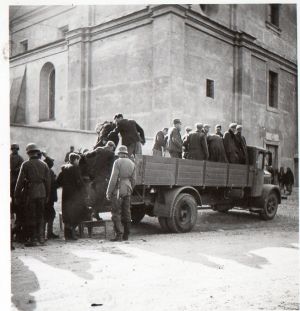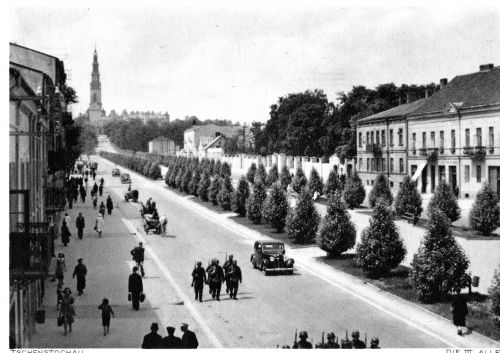Czestochowa

Jews being deported from Czestochowa
Czestochowa is a city in Southern Poland and was occupied by the Germans on 3 September 1939 and on the next day they killed 300 Jews, in an ‘Aktion’ known as ‘Bloody Monday.’ At that time approximately some 28,000 – 30,000 Jews lived in the town, out of a total population of 130,000 – 140,000 people. Until 9 April 1941, when the ghetto was established, the Jews suffered from expropriation, humiliation and maltreatment. By June 1942, the ghetto’s population had increased to approximately 40,000 – 50,000; approximately 15,000 Jews from the surrounding area had been forced to move into the ghetto.
On 16 September 1939, the Judenrat was established, led by Leon Kopinski. Other members included three lawyers, J.Gitler, Z.Rotbart, S. Pohorille, the director of the Jewish Gymnasium Wolf Anisfelt, a famous sportsman B. Kurland, L. Bromberg and N. Berliner. On 4 October 1942 all members of the Judenrat were deported to the Treblinka death camp, except for Kopinski and Kurland, together with members of the Jewish ghetto police and their families. Kopinski was shot after the deportation, whilst Kurland became chief of the Judenrat, until 22 July 1943, when he was accused by the Germans of being disloyal. Finally he was shot and killed at the Jewish cemetery. Anisfelt was responsible for the organisation of the Jewish ‘Ordnungsdienst,’ (Order Police). Its commander was a man named ‘Parasol,’ a former Polish army officer, the ghetto police numbered some 250 persons. In August 1940 approximately 1,000 young men from Czestochowa between the ages of 18 and 25 were sent to the Cieszanow, Forced Labour Camp, in the Lublin District. They were sent to construct a road; almost none survived, though one of the survivors was one Joseph Sher. The ghetto remained ‘open’ until 23 August 1941, then it was sealed off. Many Jews from Czestochowa, from other Polish towns and from Germany, Austria, Slovakia and Bohemia were forced to work and support the Nazi war effort. Forced Labour camps were established, for example in the armament factories and workshops of Hugo Schneider Metallwarenfabrik AG from Leipzig, more commonly known as Hasag and Hasag - Rakow, the former ironworks in the Rakow suburb, which was also converted into an ammunition factory. Also transformed into an ammunitions factory was the Hasag- Pelcery which was a former textile factory near the station. The foundry Metalurgia on Krotka Street and some other smaller factories and workshops all served the German war effort. There were few in the ghetto who believed that deportations would take place. Everybody assumed that the ghetto was important for war production.

Czestochowa - Die III Allee
Even when in July / August 1942 many Jews from Warsaw escaped to Czestochowa and talked about the deportations to the Treblinka death camp, the Jews of Czestochowa did not believe them. Horrible stories, told by the Treblinka escapees, were called ‘the imagination of sick brains.’ The mass deportation actions took place between 22 September 1942 and 8 October 1942. On Garibaldi Street some houses were prepared as storage rooms in which the plundered property was stored after the deportation. All entrances to the cellars were painted white, so that the Germans could quickly find Jews that were trying to hide. The first ‘Aktion’ was organised on Yom Kippur, 21-22 September 1942. In the night SS and Ukrainians from the Trawniki SS Training camp surrounded the ghetto and installed lamps on the streets. Then the Jews were forced out from their flats and houses. They had to gather in front of the Metalurgia factory, where a selection took place. Around 7,000 Jews were forced to march to the railway ramp at Zawodzie. There they had to enter the cattle wagons that were waiting there and they were deported to Treblinka. Some 200 people were killed on the spot, whilst 350 were selected for work. A mass grave for the murdered Jews was dug on Kawia Street. One of those deported to the Treblinka death camp was Eugen Turowski, who escaped during the prisoner revolt on 2 August 1943 and who survived and testified in the Fedor Federenko denaturalization trial in Fort Lauderdale in 1978: The evacuation started in 1942. We were asked to leave our apartments and houses and Germans put us all together in one of the main squares of the City of Czestochowa and then the whole transport – the whole group of people had to march to the railroad station. During this march we were not told anything at all, nothing at all. In the same transport marching to the railroad station, a group of people marching to the railroad station, I had my wife, my mother-in –law and two sisters –in-law. Since I was a professional mechanic on this square where we all met, I was collected by a German officer who knew that I was a professional man and he put me aside from the rest of the people who were going with the transport. The rest of my family went with the first transport, with the original transport. The next ‘Aktions’ were organised on 25-26 and 28 -29 September 1942. The selections took place on streets and courtyards. The Germans informed the members of the Judenrat that the Jews would be deported to work camps in Eastern Poland. Those who had been deported ‘are already working and happy.’ Through loudspeakers they told the remaining Jews that all deportees lived in good conditions in the camps and that each volunteer would get 1kg bread, jam and a plate of soup. Therefore many people went to the deportation square voluntarily. Another deportation took place on 4 October. Among those deported to Treblinka were members of the Judenrat and many Jewish policemen were deported to Treblinka.
The last transport on 7 October 1942 stopped in the small town of Koniecpol and around 1,500 from Koniecpol were added to the transport destined for the Treblinka death camp. During the liquidation of the Big Ghetto approximately 40,000 Jews from Czestochowa were deported to Treblinka. Every death train consisted of 60 cattle wagons, each occupied by approximately 130 persons. About 2,000 people were murdered in the ghetto, including tenants of old people’s homes and children from orphanages. After the deportations only 5,000 Jewish forced labourers remained in the Small Ghetto, most of them strong, or well educated. The Small Ghetto was located in the Northeast corner of the former Big Ghetto, at Nadrzeczna, Kozia, Mostowa, Spadek and Garncarska streets. It was the poorest and oldest part of the town. The ghetto was surrounded by barbed wire and had only one gate on Garncarska Street. In the official German documents this ghetto was called ‘Zwangsarbeitslager Tschentochau.’ Some Jews had to sort out plundered property in a big storehouse on Garibaldi Street. Others worked in the town’s factories and several workshops. All Jews in the Small Ghetto had to wear numbers on their clothes. On 4 January 1943, a first selection took place in the Small Ghetto. 350 women and children were deported to Treblinka and 200 other people were executed on Kawia Street. In March 1943 the Gestapo organised an ‘Aktion’ against the intelligentsia: 130 people were shot at the Jewish cemetery. On 25 June 1943 the Nazis selected people for work camps near the Hasag factories. At the beginning of July 1943 the Small Ghetto was liquidated. The last selection took place on 20 -22 July 1943 when the last Jewish ‘Ordnungsdienst and the last chairman of the Judenrat Bernard Kurland, were selected together with people unable to work. They were all executed at the Jewish cemetery. Hasag - Pelcery was the biggest forced labour camp in Czestochowa.
By the end of June 1944 approximately 5,000 Jews from Czestochowa and Lodz were forced to work there. In August 1944 another group of Jewish prisoners arrived at Hasag. They came from other work camps of the Hasag Company in the Radom district: Skarzysko- Kamienna, Radom, Kielce and from the Luftwaffe work camp in Deblin, which was in the Lublin district. All these people were evacuated to Czestochowa because of the Soviet Army offensive in the summer of 1944. By the end of 1944 it was one of the biggest labour camps in the General- Gouvernement with around 10,000 Jewish prisoners. The Jews lived in overcrowded barracks. Many of the inmates died of starvation, the cruel treatment or from typhus. In December 1944 Hasag - Pelcery came under the control of the SS and conditions became worse, similar to those in German concentration camps. On 15 -16 January 1945, because of the Soviet offensive, the SS evacuated the camp. Around 5,000 prisoners were sent to the concentration camps Buchenwald, Gross-Rosen and Ravensbruck where most of them perished. Worthy of mention is the fact there had been a Jewish resistance group established since the summer of 1942. Their first attempts at armed resistance were seen during the liquidation of the ‘Big Ghetto’. The main headquarters of the ZOB was on Nadrzeczna Street 66, hence this group was called ‘Fighting Group 66.’ In June 1943 the leader of this group, Dr Adam Wolberg, was denounced to the Gestapo and killed. Between 23 and 26 June 1943 the SS surrounded the ‘Small Ghetto’ in force. Those resistance fighters who were captured were immediately deported to Treblinka and the ‘Small Ghetto’ was liquidated.
SS- Hauptsturmfuhrer Paul Degenhardt, who was part of the Czestochowa Gestapo. Degenhardt killed Jews personally and was described as a ‘perfect organiser.’ After the war he was sentenced to life imprisonment by a court in Luneburg, Germany because of the shooting of Jews. Degenhardt replaced Hauptmann Heutz in the spring of 1942, as chief of the Czestochowa police. Between the spring and summer of 1942 the police command was extended from 30 -40 to 50 -60 men. Their headquarters were located at the Polish townhouse at Marienallee Strasse 75.
Degenhardt was also the chief of approximately 240 Polish policemen and the Jewish Ordnungsdienst. He was subordinate to the Orpo (Order Police) commander SS- Standartenführer Dr. Bottcher, who was the SS und Polizeiführer Radom. Dr Bottcher was tried and sentenced to death in 1949. Bottcher together with his adjutant Blum and Kriminalrat Feucht, activated Aktion Reinhardt in Czestochowa. Feucht, experienced in deportation actions, organized the ‘resettlement’ trains and the police troops that assisted the Czestochowa police during the resettlement actions. In the summer of 1942, Bottcher, Blum, Feucht and Degenhardt met in Czestochowa. Degenhardt produced a map of the ghetto and explained the important facts about the Jews who lived in the ghetto. Bottcher appointed Degenhardt leader of the ‘resettlement’ actions, commanding all activities. Later Degenhardt called himself the ‘Father of the Jews. The Jews themselves regarded him ‘as the master of life and death.’ Only around 5,000 Jews were still alive when the Red Army liberated Czestochowa on 17 January 1945, among them 1,500 Jews from Czestochowa itself.
Sources:
Encyclopedia of the Holocaust - published by Macmillian Publishing Company New York 1990
Anna Bieszk's, Paulina Cisowska's, Marysia Krefta's and Dorota Lygas' website .
Dr Dick de Mildt,
Testimony by Eugen Turowski, Fedor Federenko De-naturalisation Trial Fort Lauderdale, July 1978, Wiener Library
Judenrat Files - USHMM
Photographs: Tall Trees Archive
© Holocaust Historical Society 2018

